The announcement by Microsoft of Halo Wars 2 at E3 last year, surprised many. Even after all these years, original games in the Real Time Strategy genre are not a staple. Whether it is the cumbersome task of transferring the control scheme from a PC to a controller, or simplifying the gameplay. It largely remains something seen on Steam and not on consoles. Nearly seven years ago, Ensemble Studios accomplished these tasks with Halo Wars. Halo Wars is backwards compatible for anyone that already owns the game. However, anyone looking to try out the game for the first time may find something interesting. Especially, if one is biding their time until the second game releases.
Halo Wars Definitive Edition Review
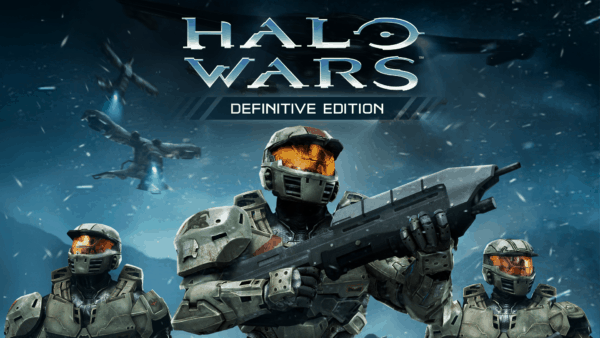
Title: Halo Wars: Definitive Edition
Platform: Xbox One [Reviewed] PC (Windows 10 Only Via Xbox Play Anywhere)
Genre: Real Time Strategy
Developer: 343 Industries (Original Halo Wars Developer: Ensemble Studios)
Publisher: Microsoft Studios
Players: 1-2 Campaign (Co-op is Online Only), 1-6 Online Multiplayer
Release Date: December 20, 2016, (Original Halo Wars Release: February 26, 2009)
Price: Currently available only as a Pre-Order of Halo Wars 2 Ultimate Edition, sold separately starting Feb. 21, 2017
Even After Seven Years, Things Stay the Same
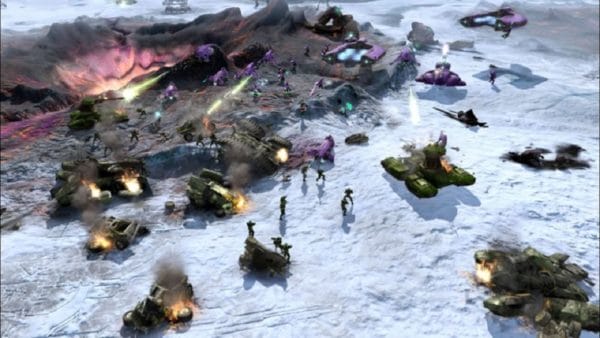
I feel it’s important to get this information out at the beginning, as sort of a disclaimer. Especially, for those that may have played the original Xbox 360 version. Since there could be some that wonder if it’s worth picking up a Xbox One edition.
Other than running at a smooth 1080p and 60 FPS and including all the DLC, which is mainly multiplayer maps. It also runs up to 4K on PC. Everything about Halo: Wars Definitive Edition is exactly the same, as its Xbox 360 counterpart. So, if you are getting this as a Halo Wars 2 pre-order incentive, it is totally worth it. However, unless you are completely new to the series, there may not be enough here to justify a separate purchase. The game does run much better on Xbox One. I never noticed any issues, even when there was a lot of action going on screen.
There are probably quite a few folks that weren’t even playing games in 2009. Let alone know the development history of this game. Halo Wars was developed by Ensemble Studios, also known for the hugely popular Age of Empires series. Shortly after the release of Halo Wars, Ensemble was closed down. So, this is probably the biggest reason nothing new was added to the game. Not to mention, Creative Assembly is hard at work on finishing Halo Wars 2. Going back to add extra content to a seven year old game, is not a huge priority.
Halo Universe

Personally, I’m not someone that plays RTS games. Give me a Strategy Role-Playing Game and I’d probably give it a shot. RTS games just have too much going on for me to understand. The draw to the original, like for many others, was probably the Halo tie-in. Being a huge fan of the Halo universe, it gave me a reason to want to play the game. Ensemble and Microsoft absolutely honored that by showing some major love and affection to the Halo lore. From the moment a player starts the game, they are treated to familiar looking menus. Music akin to what’s in the other games. Not to mention, campaign and multiplayer modes.
Inside the actual 15 Campaign missions and in the Multiplayer Skirmishes, the care for the Halo license shows. The game is set 20 years before the events of Halo: Combat Evolved and while it contains unfamiliar characters, it is all very Halo. Similar to Halo 1, you are only in control of the UNSC. The main ship, named Spirit of Fire houses commanding officers and Serena, who is the navigation A.I. similar to Cortana. However, unlike Cortana, this is her sole duty. The two main characters, the Scientist Anders and the commander on the ground Forge. Both don’t offer much depth, but honestly, the story isn’t why one is playing this game. To be fair, it’s not like 343 Industries or Bungie nailed a great story on every game either.
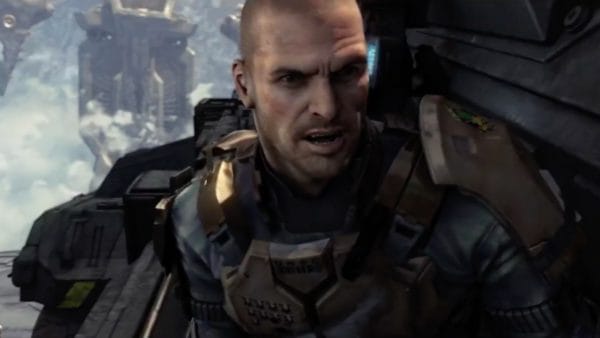
Each mission begins with a beautiful cutscene. Either involving the UNSC or the Covenant. Longtime Halo fans should recognize The Arbiter. While also seeing plenty of Spartans, although Master Chief never appears. Basically, it all still comes down to UNSC versus Covenant, while the The Flood makes their presence felt too. All of the familiar units are around. Warthogs, Scorpions, even ODST Marines. Not to mention, all those on the Covenant side as well for you to battle against. There’s even skulls and black boxes to pick-up as mission extras.

All Units
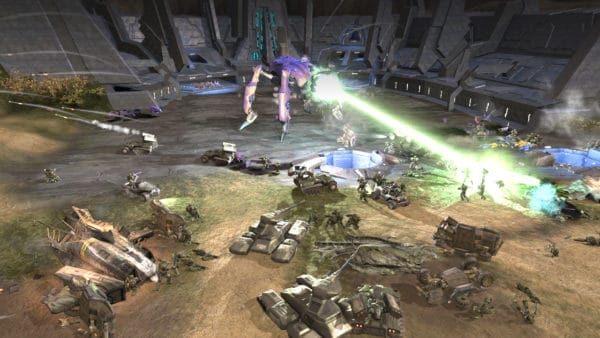
Until Halo Wars released, RTS games on console only appeared as PC ports. Ensemble Studios used the Halo license to create a simple and console friendly RTS. This means longtime RTS veterans may malign the lack of control options. For genre newbies, or people like myself, it makes the complexities easier to stomach. Most missions ask you to build a base and construct reactors. Supply said base and choose what type of units you’d like to build. Many of the early missions limit what can be built. However, as the missions progress, you have more freedom to take Hornets and Vultures to the skies, or keep things on the ground with Scorpions and Wolverines. Then, it expands to special abilities like racking up reserves or building up the MAC cannon with a Field Armory.
Players can choose to command all units at a time by pressing LB. While pressing RB grants control of local units within a certain area. Individual units can also be selected with the A button. Although you can cycle through certain groups or by pressing RB and the analog stick, I found it easier to just use all at once. Unless I was in a mission where I needed to separate the teams. Once you reach the enemy, you can send them to attack as normal, or use their charged special ability by pressing Y. For example, a Warthog can run over grunts. While Marines use a more powerful weapon. Hornets can use missiles too. Each unit also has at least one upgrade that gives them a defensive ability such as the Scorpion’s Cannister Shell. It can also be a more offensive ability like a bigger amount of missiles for a Vulture.

The campaign objectives vary as you go through the 15 missions. For one, you may have to take out a Scarab, while in another, there’s groups of Spartans who need saving. Many of the missions do end by destroying the Covenant base or multiple bases. Similar to the numbered Halo games, difficulty is really what makes this worthwhile. I played the whole campaign on normal and only ran intro trouble on a few missions. However, once I bumped the difficulty up to Heroic there was more of a challenge. If you find that doing things solo isn’t enough, you can also hop online and play the campaign with a friend.
The Good and Bad of Simple
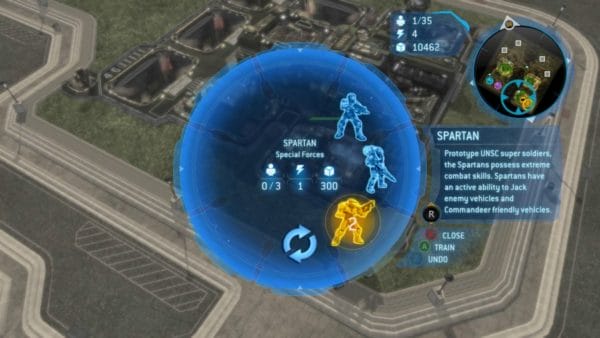
Mainly, what I enjoyed is how easy it was to setup a base and get units rolling quickly. I wasn’t bogged down with minutia of selecting through so many kinds of units. It was easy to see where the upgrades were and the game explained them. So, I could decide if I wanted to use medics or instead use the healing ability. Then, the focus could go on something else. This goes even further, once there are missions where you are tasked with multiple bases.
However, this may be where the game falters a bit. The over simplification can create situations where you just keep pumping out the same units every mission. Controlling multiple bases on the later missions at higher difficulties does add some chaos and variety though. Ultimately, the campaign is more preparation for the multiplayer. Regardless of difficulty, the campaign is fun. But there’s not many situations where your base will get overrun. Especially, if you figure out how to keep bases protected, while also having enough units to take out the objectives. How quickly one grasps the game can determine how much trouble you’ll have in the missions.
Another fault with improving on a game that is seven years old, without the original developer is assets. It’s a bit obvious at times that the same assets from the 360 version are in use on the Xbox One version. Let’s be honest, it isn’t like it takes away from the game at all. Just something noticeable from time to time.
Multiplayer Modes
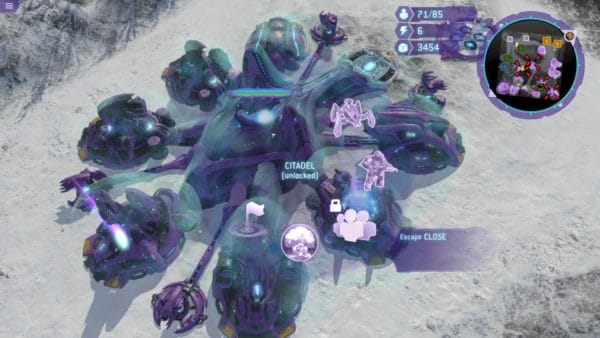
It just wouldn’t be Halo without some multiplayer. Multiplayer boils down to different types of Skirmishes that are available. There are three kinds of multiplayer maps. 1 vs. 1, 2 vs. 2 and 3 vs. 3. These can be played with other players, or you can have A.I. control the other two units on your team. There is matchmaking for multiplayer and you can also join another person’s skirmish at any time to help out. Several of the Halo staples are here. Death Match, Capture the Flag and more. Obviously, the bigger the map, the more chaotic and huge the battles are. It’s a total spectacle to watch three bases worth of units go at it. Here’s also where one can play as the Covenant and use their forces as well.
This is where the game shines. While playing with A.I. units for practice gets you into the swing of things, there’s nothing like playing against a human opponent. The objective in a regular skirmish, is to take out the player’s base. Each map has multiple bases one can control. Things change when you play 2 on 2 or 3 on 3, because from the outset each person has a base all to their own, to build as they see fit. You can also send one of the other bases supplies, which helps them build what’s needed a bit faster. Multiplayer also showcases exactly why the campaign can be looked at as a giant tutorial for this mode. In multiplayer, you can’t just simply wait around until you’ve produced all the units you want. There’s a bigger strategy involved.
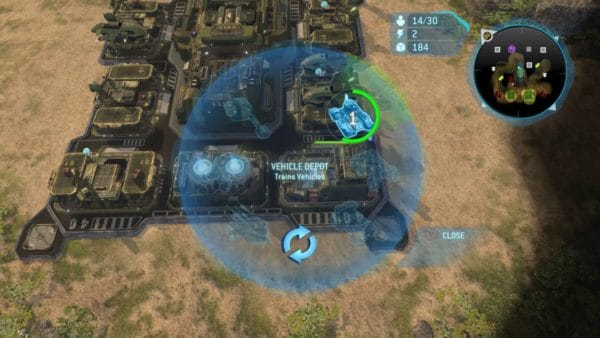
You may have to coordinate with your team to decide who’s focusing on what type of unit. Depending on the skill of the opposition, you may have to build and go. Produce a sufficient amount of units to get things rolling and then hope they can hold things down, while you build the main focus of your army. Obviously, depending on the main objective, you may also have to decide to leave units at home to defend the base. This causes the strategy to be even tighter, because if the enemy coordinates things and you went all on the attack, capturing a flag is pretty easy at that point. Much like with regular Halo multiplayer, this is the driving force of Halo Wars. When it comes to other shooters, I don’t even bother with the multiplayer because it’s usually above my head. What I’ve always loved about Halo’s multiplayer is that it is accessible to all kinds of players. The same goes for Halo Wars.
Pros
Game is easy to understand and play
Strips down Real Time Strategy for use on a controller
Lots of love for the Halo Universe
Multiplayer has lots of modes
Online Co-op for Campaign
Cons
Reuse of Assets can be a bit obvious
Campaign sometimes feels like a giant tutorial
Not a game for experienced RTS players
Final Rating
Overall Thoughts: 8 out of 10 Halo Wars was a landmark for its time. Ensemble Studios created a game that’s simple to understand for RTS newbies and has something Halo fans can enjoy too. The love for all things Halo shines through in Halo Wars. The care given to the license is uncanny and provides a nice warm-up while waiting for Halo Wars 2. The campaign isn’t the greatest, but the multiplayer is lots of fun. I don’t know that I can recommend this as a separate purchase for anyone that owns or played the first game. However, If you want to complete the Halo saga, or are perhaps looking for something a bit easier from Real Time Strategy, this fits that bill. Let’s hope Halo Wars 2 builds upon its predecessor and delivers even more.
* for the sake of transparency, the publisher did send a code for review purposes. *
